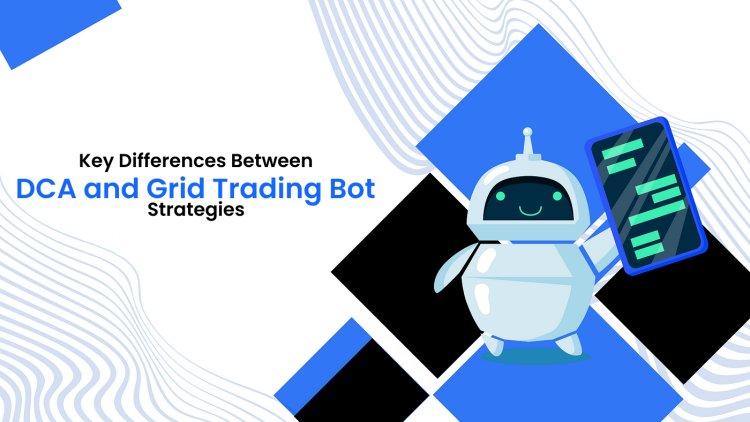Key Differences Between DCA and Grid Bot Trading Strategies
In this blog, we'll delve into the key differences between DCA and Grid Bot trading strategies, and how these differences impact traders' decisions. We'll also explore the development aspects of these bots, highlighting the benefits and challenges of each.
Share this Post to earn Money ( Upto ₹100 per 1000 Views )

In the realm of automated trading, two strategies stand out for their effectiveness and popularity: Dollar-Cost Averaging (DCA) and Grid Trading. Both strategies aim to optimize trading outcomes, but they differ significantly in their approach and execution.
In this blog, we'll delve into the key differences between DCA and Grid Bot trading strategies, and how these differences impact traders' decisions. We'll also explore the development aspects of these bots, highlighting the benefits and challenges of each.
What is Dollar-Cost Averaging (DCA)?
Dollar-cost averaging (DCA) is a straightforward investment strategy where a fixed amount of money is invested at regular intervals, regardless of the asset's price. By using this technique, the entire purchase should be less affected by volatility. Investors can average the purchase price over time by spreading out their purchases to prevent making a sizable investment at an unfavorable period.
Key Benefits of DCA
1. Reduced Impact of Volatility:
By investing regularly, the average purchase price becomes more stable, reducing the impact of market fluctuations.
2. Simplified Decision-Making:
Investors don't need to time the market, making it easier to stick to a consistent investment plan.
3. Disciplined Investing:
DCA promotes disciplined investing, which can be beneficial in volatile markets.
What is Grid Trading?
Grid Trading is a strategy that involves placing buy and sell orders at predetermined intervals above and below a predetermined price. The aim is to profit from market fluctuations by executing trades at these intervals. The strategy creates a "grid" of orders, allowing traders to capitalize on both upward and downward market movements.
Key Benefits of Grid Trading
1. Profiting from Volatility:
Since grid trading makes money from price swings, it is particularly successful in unstable markets.
2. Automation:
The strategy can be fully automated, reducing the need for constant market monitoring.
3. Flexibility:
Traders can adjust grid parameters to suit different market conditions and risk appetites.
Key Differences Between DCA and Grid Trading
1. Objective:
- DCA: Focuses on accumulating assets over time, regardless of market conditions.
- Grid Trading: Aims to profit from market volatility through frequent trading.
2. Market Conditions:
- DCA: Ideal for long-term investors looking to mitigate the impact of volatility.
- Grid Trading: Best suited for traders seeking to exploit short-term price movements.
3. Implementation:
- DCA: Involves regular, fixed-amount investments.
- Grid Trading: involves putting several buy and sell orders at pre-established price points.
4. Risk Management:
- DCA: Generally considered lower risk, as it spreads investment over time.
- Grid Trading: This can be a higher risk due to frequent trading, but offers potential for higher returns in volatile markets.
Developing DCA and Grid Trading Bots
DCA Bot Development
Developing a DCA bot involves creating a system that automates regular investments. Key considerations include:
1. Investment Amount:
The bot should allow users to set a fixed investment amount and interval.
2. Asset Selection:
Users should be able to choose which assets to invest in.
3. Risk Management:
Risk can be managed with the use of features like take-profit and stop-loss settings.
Grid Trading Bot Development
Grid Trading bots require a more complex setup to manage multiple orders. Key considerations include:
1. Grid Parameters:
Users should be able to set grid size, order intervals, and price range.
2. Order Management:
The bot needs to handle multiple buy and sell orders efficiently.
3. Risk Management:
Incorporating features like stop-loss, take-profit, and dynamic grid adjustment can enhance the bot's performance.
Conclusion
For traders who want to maximize their assets, it is essential to understand the main distinctions between DCA and Grid Trading techniques. DCA offers a simple, disciplined approach to long-term investing, while Grid Trading provides a flexible, automated strategy to profit from market volatility. Developing bots for these strategies involves addressing specific requirements and challenges, but the potential benefits make it a worthwhile endeavor.
Whether you're interested in Grid Trading Bot or DCA Bot, choosing the right strategy depends on your investment goals and risk tolerance. By leveraging these automated trading strategies, you can enhance your trading efficiency and potentially achieve better returns in the dynamic world of cryptocurrency trading.





![Glyco Care South Africa Reviews [New Updates 2024] Read Before Buy!](https://blog.rackons.in/uploads/images/202407/image_380x226_6698f7cc053aa.jpg)

